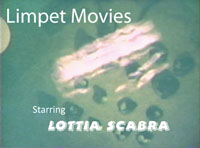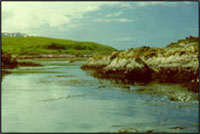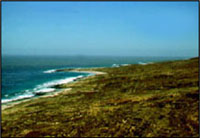 |
||
 |
||
| Home | People | Research | Publications | Contact Us | UC Musuem of Paleontology |
David R. Lindberg | |||
 |
 |
 |
|
. . . to knock a limpet from the rock does not even require cunning, that lowest power of the mind. Charles Darwin, 1834 Phylogenetics is at the core of Integrative Biology. The evolutionary history, interactions, and relationships of the taxa that I study are the threads that unite the various temporal and spatial scales of my research. My research program primarily centers on evolution in the rocky, nearshore marine biome. Rocky intertidal of Gibson Island, Bering Sea, Attu Island, Aleutian Islands, Alaska A My interest in this habitat has sustained over 15 years of research and field work along much of the eastern Pacific margin, including the Aleutian Islands, Washington State, the northern and southern California and related island groups, the islands of Baja California, Mexico, and the temperate coast of Chile. Most of my early work consisted of faunal surveys and community level studies with the California Academy of Sciences.
Research at this scale requires a wide variety of techniques and I often incorporated paleontological, geological, and biogeographical data, in addition to comparative morphology, developmental biology, long-term experimental manipulations, and phylogenetics in my studies. Molecular approaches have been added to this repertoire [visit the Molecular Phylogenetics Laboratory]. My research often centers around one of three recurrent themes:
Current systematic research efforts are focused on the construction and use of phylogenetic hypotheses to understand adaptation and I also continue to investigate the relationships amongst higher molluscan taxa including subclades within the Gastropoda, the "conchiferian" groups, and the phyletic position of the Mollusca. Data sets include morphological characters, molecular characters and fossil and Recent taxa, providing a total evidence approach. My work on the evolution of the rocky intertidal settings has been downsizing over the last few years, but I remain interested in the role of the substrate in determining and augmenting community composition and subsequent species interactions, and the continuing analysis and publication of the San Nicholas Island Lottia gigantea studies (1979-1991) conducted with James A. Estes. I also remain interested in the effects of glaciations and humans on the evolution of nearshore marine systems, especially on marine mammal and seabird populations around the Pacific Rim. |
|||
Contact info:Lindberg LabDepartment of Integrative Biology 1005 VLSB MC #3140 Berkeley, CA 94720 - 3140 Lab phone: (510) 643.9746 IB Fax: (510) 643.6264 UCMP Fax: (510) 642.1822 Email: drl (at) berkeley.edu |
Links |
||
| Berkeley Natural History Museums | |||

| Doberman Rescue | ||
BACK TO TOP | |||
| University of California, Berkeley | Department of Integrative Biology | |||
 lthough rocky shores account for over 30% of the world's coastlines, biome level questions and patterns are seldom addressed. My approach at this large scale focuses on the evolution of select organisms (mostly Mollusca), the changing habitat, and the resultant interactions between organisms and between organisms and the habitat through time.
lthough rocky shores account for over 30% of the world's coastlines, biome level questions and patterns are seldom addressed. My approach at this large scale focuses on the evolution of select organisms (mostly Mollusca), the changing habitat, and the resultant interactions between organisms and between organisms and the habitat through time.
 evolution in patellacean faunas in different regions of the world through time. These data are used to examine evolutionary and biogeographical patterns in other rocky intertidal taxa, and preliminary data suggest that some of these patterns are common to several unrelated molluscan groups.
evolution in patellacean faunas in different regions of the world through time. These data are used to examine evolutionary and biogeographical patterns in other rocky intertidal taxa, and preliminary data suggest that some of these patterns are common to several unrelated molluscan groups.